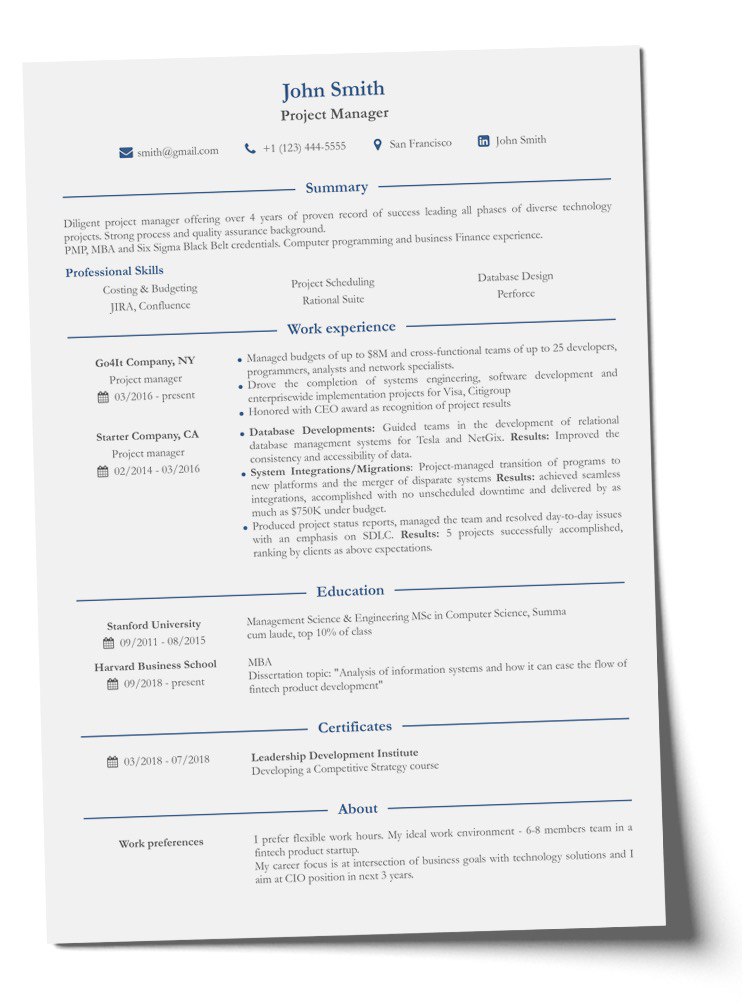Do you want to get a job at an international or IT company? Are you going to work abroad? Wonderful! These are vital steps for climbing the career ladder, as well as for your personal development. Writing your resume in English is your ticket to an exciting new life. This guide will make sure that your resume presents you as an offer that companies cannot refuse.
In this article you’ll learn:
- What a classical resume in English looks like
- Features of each section, as well as tips and common mistakes to avoid when writing them
- Examples of key and set phrases
5 Tips for Writing your Resume in English
1. Contacts: Download internationally used messaging apps for communication and remaining contactable, including WhatsApp, (FB) Messenger and Skype.
2. Summary: Write a persuasive ‘elevator pitch’ summary.
3. Education: Use common abbreviations: BS, MA for an academic degree, GPA for an academic average grade
4. Skills: Categorize as hard or soft skills.
5. Style: Use a more striking tone of writing for a resume intended for North American companies (USA, Canada) and a moderate tone for the European job market.
5 Mistakes to Avoid When Writing Your CV in English
1. Don’t attach your photo when writing a resume for jobs in the USA or UK.
2. Avoid stereotypical, clichéd phrases, such as experienced hard-worker, out-of-the-box thinker, great team player, etc.
3. Don’t mention common, obvious skills like, proficient in Microsoft Word, Windows user – nowadays, these are no different than reading and writing skills.
4. Don’t exceed a one page limit for the USA and two pages for the EU.
5. Don’t forget: Capitalize every word in job titles, company names, degree names, and your university/college.
Here is an example of a resume in English that features all our recommendations. We’ll describe each one as we go along below:

English CV sections in detail:
1. Personal and Contact Details
Personal Details: Your first name should go first, then your family name/surname. It must be the same as it appears in your passport.
Contacts. Download internationally used messaging apps for contacting potential employers and ensuring you remain contactable. These include WhatsApp, Facebook Messenger, and Skype. You should also use WeChat, if a company is Chinese.
Besides an email and phone number, you can add a social media link: LinkedIn for the USA and Europe, aside from Germany, as they use Xing. A professional recruiter will look up your social media profile to make sure your values and worldview align with their company’s. It’s best to anticipate this and prepare for it accordingly in advance…
Don’t write your full address, your city is enough.
Here is an example of how contact details should be filled out:
Tip 1: Photo. If you send your resume to an American or English company, make sure to send it without a photo. For European companies, meanwhile, a photo is expected.
Social media link
Birthday, family status (it can be forbidden by law for recruiters to ask for these details)
2. Summary
In the Summary section, a candidate is required to the strongest and most important aspects of their work experience sides to capture a recruiter’s interest and make them want to read further.
It’s a short self-presentation, like an elevator pitch, named as such because it should be able to be said in the time it takes to ride an elevator.
Here’s an example of a summary:
Here are 3 priceless sentences for your resume: Be brief. Be bright. Be gone.
William Vanderbloem
Forbes author
3. Work Experience
If you have at least one year of work experience, this section should be placed after the Summary; it is the most important for a recruiter. Write about your professional experience, from your last, or current, job to your first one.
Use the bullet points principle: it makes reading more convenient for recruiters. Plus, non-native speakers can make punctuation mistakes.
Note: if each point is a full sentence, it should begin a capital letter and end with a full point. If it’s not a full sentence, but rather a phrase, you can start it with a capital or lowercase letter and use no punctuation marks.
For example:
- Our department managed to complete 10 projects in two months.
OR
- 10 projects completed in two months
Don’t mix different types of bullet points, i.e, full sentences and phrases, stick to one throughout.
Apply the same principles when listing achievements. In addition, use active verbs in Past Simple tense (completed, achieved, created)
For example:
- released 20 applications in App Store and Google Market
When describing your work obligations, use gerunds (a verb with an ‘–ing’ ending).
For example:
- communicating with clients
- preparing press-releases and articles on business subjects
If you use noun clusters, like marketing activities, don’t use more than 3 nouns in succession.
Tip 2: Job position writing: If you have worked in non-English speaking countries, translate your position in an appropriate way. Try to find a job role with similar obligations on international websites (monster.com or indeed.com).
Work Experience Section Example:
4. Education
The Education section should come after the Summary, if there is no relevant work experience.
When writing the name of an educational institute, don’t use abbreviations as recruiter may not be familiar with it. For instance, instead of QMUL – Queen Mary, University of London.
There are different education systems in different countries, so it can be a problem for employers to understand the difference between academic degrees. You’ll find below traditional ways of referring to your academic degree in English below:
| undergraduate | student |
| bachelor’s degree student | bachelor |
| master’s degree student | master |
| postgraduate | PG student |
| doctoral candidate | doctoral candidate |
In the American version of these descriptions, you’ll frequently find an indication of the field of study, as well as the degree:
STEM fields:
Bachelor of Science (BS)
Master of Science (M.S.)
Doctor of Science (S.D.)
Arts:
Bachelor of Arts (BA)
Master of Arts (M.A.)
Doctor of Philosophy (Ph.D)
Tip 3: You can take a peek at the English way of writing about your university, speciality and degree on the English version of their website or from former graduates on LinkedIn profiles.
If you want to refer to your average score, write it as follows: GPA 4.5 (5) – where GPA is grade point average, 4.5 is your result, and 5 is the maximum score. When mentioning graduating with a distinction, it is better to use the generally accepted Latin term “cum laude”.
In the USA, a distinction is of great importance and is calculated very precisely, based on the ranked position in the graduating class rating. For example, summa cum laude (with the highest distinction) – top 5% of the class.
When you put it all together, your Education section might look like this:
Tip 4: Capital letters: Each word in your title, degree, university/college, and job position should be capitalized.
For example, Master of Law, Customer Sales Representative at Microsoft
5. Skills
In English, skills are divided into hard and soft skills. Hard skills are those necessary for a specialist to perform their job role. They depend on work experience, certificates, and education and also answer the question of what you can do. Soft skills are your personal qualities, how you relate to people, and your approach to solving problems.
Hard Skills:
SEO marketing
Python programming language
Bookkeeping
Soft Skills:
Negotiation skills
Conflict management
Analysis
Self-motivation
Language levels. They are usually indicated on a scale from A1 (Elementary) to C2 (Fluent). You can find more details about English proficiency levels and how to determine your skill level here.
6. Certificates & About
Optional sections are Certificates / Courses and About.
The first one demonstrates your professional development, and the second one reveals you as a person. In the About section, avoid buzzwords – cheesy phrases.
In the About section, mention those hobbies that emphasize your personal qualities on a nice side.
Managed/directed team and implemented 1,2,3
Succeeded at A, B, C
outside-the-box thinker
excellent communicator
7. References
Western companies expect a candidate to provide references (contact details of people who can provide feedback about your work). Therefore, at the end of an English CV, write References: Available upon request. Check with your referrers in advance which method of communication (phone number, email, etc) is most convenient for them.
Final tips:
Tip: Resume format – PDF: Why not a standard Word document? In PDF format, your resume sample will look exactly as you wrote it, while in .docx, sentences and paragraphs could be shifted in different versions. Besides, it’s not guaranteed that a recruiter has Word installed.
Tip: A resume’s length for the United States should not exceed 1 page. Conciseness plays a big role but you should also clearly highlight your main skills in order to be noticed. For Europe, on the contrary, a resume’s length may be 2 or even 3 pages and should have a more neutral tone of writing.
Bonus: Useful resources
As a reward for reading this far, we’ve included a few useful links to sites that will further help you craft an excellent resume in English.
Thesaurus – Check your resume for repeated words that are similar in meaning.
Business Insider – A guide to overused words or words to avoid using in your resume.
Grammarly – Check that your resume is grammatically correct.
We hope this guide to writing your resume in English will help you land a fantastic job overseas and serve you well in the long-run. Better still, you can apply what you’ve learned directly on our website, in our online resume constructor. It already contains all the correct structure, correct format for names, and will help you implement the tips offered in this guide.
We sincerely wish you all the best in securing stress-free interviews and pleasant work!




